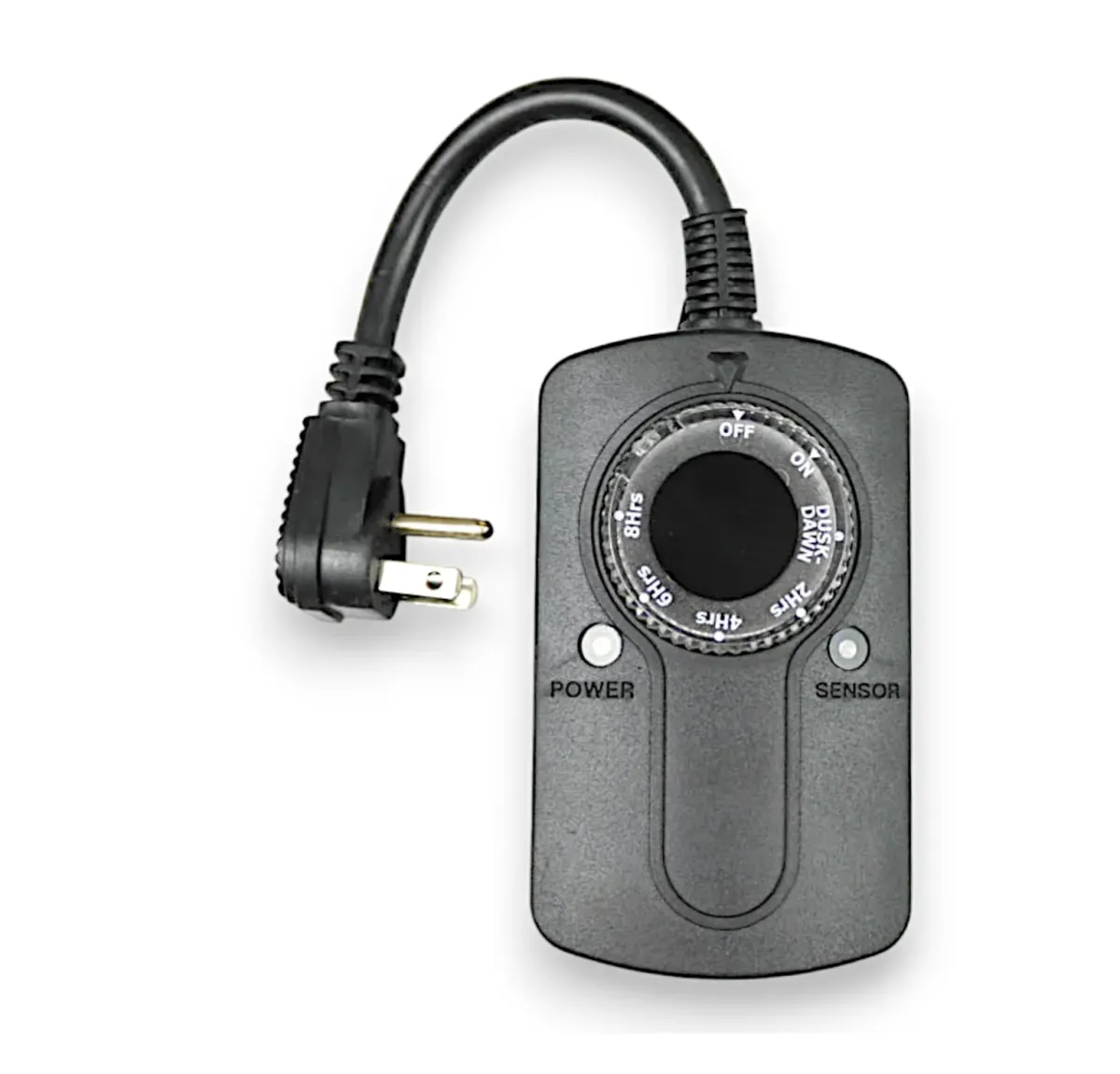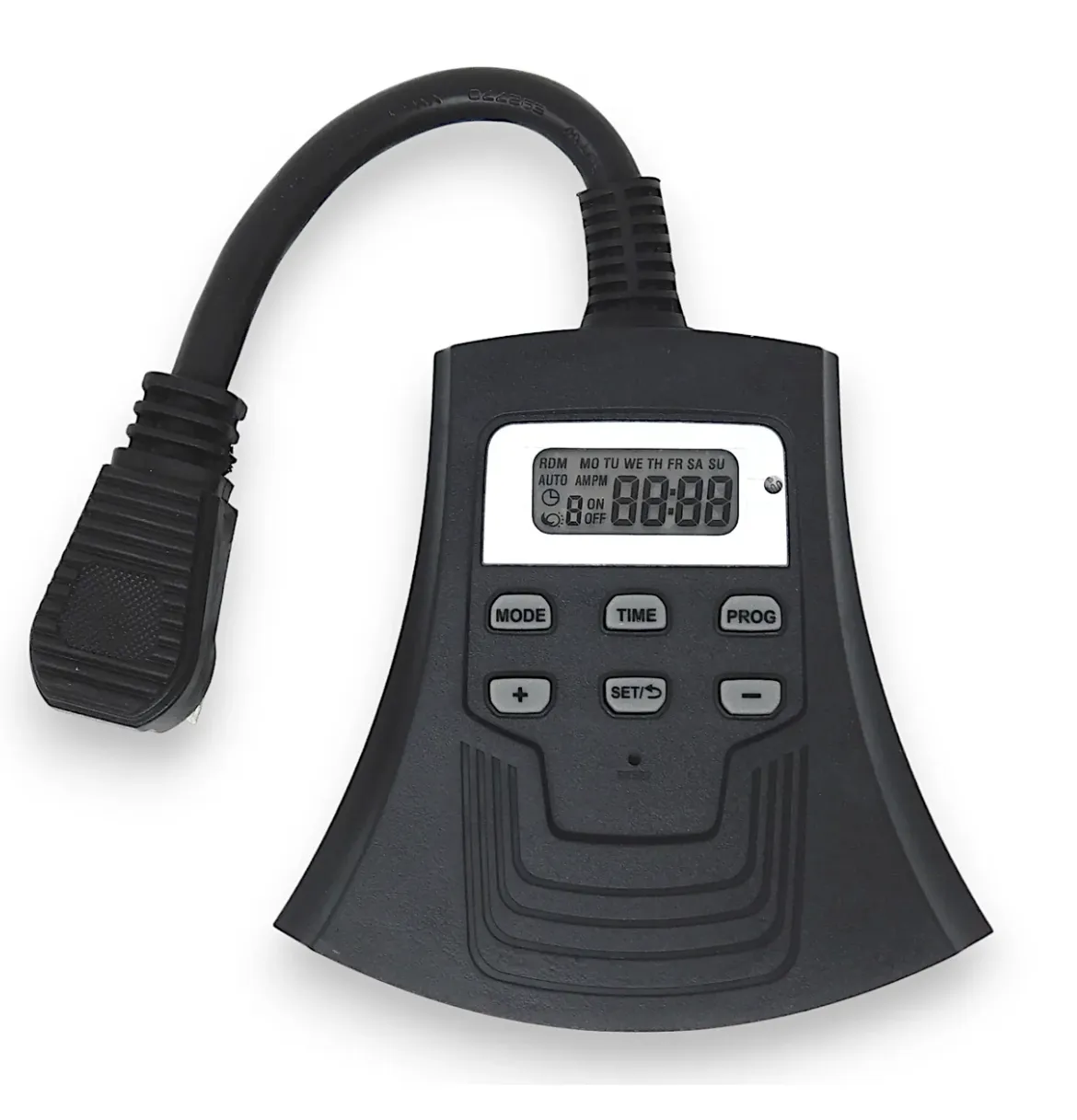Precision Control for Your Holiday Illuminations: Professional-Grade Outdoor Timers
Elevate your holiday lighting displays with our collection of professional-grade outdoor timers. These essential tools offer precise control and energy efficiency for your festive illuminations. Whether you're a professional installer or a homeowner looking to enhance your holiday decor, our range of timers provides the perfect solution for managing your lights with ease. From photo cell timers that automatically adjust to daylight changes, to digital and mechanical options offering customizable schedules, our selection ensures your displays shine at just the right times. Designed for both indoor and outdoor use, these durable timers combine convenience with reliability, helping you create magical holiday atmospheres while conserving energy. Discover how our timers can transform your lighting management and take your seasonal displays to the next level.
Timers
Photo Cell Timer
Enhance your holiday lighting control with our versatile Photo Cell Timer featuring a convenient right-angle plug. This intelligent device offers two outlets, providing flexible options for managing multiple light strings or decorations. The timer comes with a range of settings to suit your specific needs: choose between Off, On, Dusk to Dawn, or preset durations of 2, 4, 6, or 8 hours. The photo cell technology automatically detects ambient light levels, ensuring your lights turn on as darkness falls and off when daylight returns, perfect for the "Dusk to Dawn" setting. The right-angle plug design helps maximize space usage and reduces strain on your outlets. Whether you're looking to conserve energy, enhance security, or simply enjoy the convenience of automated lighting, this Photo Cell Timer is an essential tool for effortless and efficient holiday light management.
15 AMP Digital Timer
Streamline your outdoor lighting control with our efficient Mechanical Light Timer Switch Outlet. This versatile device is perfect for managing lamps, fans, garden lights, porch illumination, or holiday and Christmas displays, helping you reduce energy waste and extend the life of your decorations. The timer features customizable daily settings that you can adjust at any time, offering flexibility to match your changing needs or schedules. Built for durability, this wall-mounted timer comes with a three-prong, weatherproof design, ensuring reliable performance in various outdoor conditions. The three-switch outlet provides multiple connection options, allowing you to control several devices simultaneously. Whether you're looking to enhance security, create ambiance, or simply automate your outdoor lighting, this mechanical timer offers a user-friendly solution for effortless light management throughout the year.
Mechanical Timer
Enhance your lighting control with our versatile In/Outdoor Mechanical Timer featuring a space-saving right-angle plug. This robust device offers two outlets, allowing you to manage multiple light strings or decorations simultaneously. Designed for both indoor and outdoor use, it's perfect for holiday displays, security lighting, or everyday household needs. The 24-hour programmable cycle provides ultimate flexibility, enabling you to set precise on/off times that repeat daily. With a powerful 15-amp capacity, this timer can handle most residential lighting and small appliance loads with ease. The mechanical design ensures reliability and ease of use, with no complicated programming required. Whether you're looking to automate your Christmas lights, control patio illumination, or simply manage energy consumption, this durable and practical timer is an essential tool for efficient light management in any setting.
Frequently Asked Questions
What types of timers do you offer?
We offer a variety of timers including Photo Cell Timers with right-angle plugs, 15 AMP Digital Timers, and Mechanical Timers. Each type has unique features to suit different needs and preferences.
Are these timers suitable for outdoor use?
Yes, all of our timers are designed for both indoor and outdoor use. They are built with weatherproof features to ensure reliable performance in various outdoor conditions.
How many outlets do these timers have?
Most of our timers, including the Photo Cell Timer and the Mechanical Timer, offer two outlets. This allows you to control multiple light strings or decorations simultaneously.
What's the benefit of a Photo Cell Timer?
A Photo Cell Timer automatically detects ambient light levels, turning your lights on at dusk and off at dawn. This "Dusk to Dawn" feature provides convenient, energy-efficient operation without manual adjustments.
Can I set specific on/off times with these timers?
Yes, our timers offer programmable cycles. For instance, the Mechanical Timer has a 24-hour programmable cycle, allowing you to set precise on/off times that repeat daily. The Photo Cell Timer also offers preset durations of 2, 4, 6, or 8 hours in addition to its Dusk to Dawn setting.
Discover Expert Tips on Our Blog

Your First Outdoor Christmas Light Display: The Complete Beginner's Guide
Welcome to the magical world of outdoor Christmas lights! Transforming your home into a festive wonderland is a cherished holiday tradition, but for first-timers, it can seem overwhelming. This comprehensive guide will walk you through every step of creating your first Christmas light display, from planning to storage, with expert advice to ensure a safe, beautiful, and stress-free experience.
Why Create an Outdoor Christmas Light Display?
An outdoor Christmas light display does more than just decorate your home—it creates lasting memories, spreads holiday cheer throughout your neighborhood, and establishes a tradition you can build upon year after year. Even simple displays can make a significant impact and bring joy to everyone who passes by.
Part 1: Planning Your Christmas Light Display
Step 1: Assess Your Home's Design
Before purchasing any lights or decorations, take time to evaluate your home's exterior:
Walk to the curb and photograph your home from different angles to use as a reference
Identify key features to decorate:
Roofline and eaves
Windows and door frames
Trees, bushes, and landscaping elements
Porch columns and railings
Walkways and driveways
Mailbox, planters, and other accents
Locate all outdoor electrical outlets as these will determine your power distribution plan
Step 2: Choose a Theme or Style
While not mandatory, selecting a theme helps create a cohesive look:
Winter Wonderland: Blue and white lights with snowflake accents
Classic Christmas: Red, green, and white with traditional elements
Elegant Monochrome: All white lights for a sophisticated appearance
Colorful and Playful: Multi-colored lights with whimsical decorations
Red and White: A candy cane inspired palette
Step 3: Set a Realistic Budget
Christmas light displays can range from less than $100 to several thousand dollars. As a beginner, establish a firm budget before shopping to avoid impulse purchases:
Entry-level display ($100-$200): Focus on a few high-impact areas like your entryway and one prominent tree
Mid-range display ($200-$500): Add roofline lighting and several landscape elements
Larger investment ($500+): Comprehensive coverage of multiple areas
Remember that investing in quality lights initially may save money long-term through durability and energy efficiency.
Step 4: Measure Everything
Take accurate measurements of all areas you plan to decorate:
Roofline length (each section separately)
Window and door perimeters
Porch railing and column lengths
Tree trunk circumference and branch reach
Bush dimensions
Walkway and driveway lengths
Record these measurements on your reference photos or a sketch of your home.
Step 5: Create a Shopping List
Based on your measurements, budget, and design plan, create a prioritized list that includes:
Lights by location (type and quantity needed)
Installation supplies (clips, stakes, extension cords)
Safety equipment (GFCI adapters, timers)
For beginners, we recommend starting with a smaller, manageable display and expanding in future years.

Part 2: Choosing the Right Christmas Lights
Types of Christmas Lights
Understanding different light types will help you select the right options for your display:
LED vs. Incandescent Lights
LED Christmas Lights:
Pros: Energy-efficient (using up to 90% less electricity), cooler-burning (safer), extremely durable, long-lasting (25,000+ hours), permit connecting many strands
Cons: Higher initial cost, different light quality than traditional incandescents
Incandescent Christmas Lights:
Pros: Lower initial cost, traditional warm glow, nostalgic appeal
Cons: Higher energy consumption, shorter lifespan (1,000-2,000 hours), fragile bulbs, generate heat (potential fire risk), limited connectivity between strands
For most beginners, the safety features and longevity of LED lights make them the recommended choice despite the higher upfront cost.
Common Christmas Light Styles
Mini Lights: Versatile small bulbs perfect for wrapping trees, outlining windows, or decorating railings
C7 and C9 Bulbs: Larger, traditional bulbs ideal for rooflines and pathways
Icicle Lights: Cascading strands that simulate icicles, perfect for eaves and overhangs
Net Lights: Pre-arranged grid of lights that easily drape over bushes and shrubs
Rope Lights: Flexible tube lighting perfect for outlining paths or creating shapes
Projection Lights: Cast patterns on large surfaces with minimal installation effort
Outdoor Safety Essentials
For outdoor installations, always choose:
Lights and extension cords explicitly labeled for "outdoor use"
UL-approved products (look for the UL label)
GFCI (Ground Fault Circuit Interrupter) protection for all outlets
Commercial-grade lights for better durability if budget allows

Part 3: Essential Tools and Supplies
Having the right tools and supplies before you begin will make installation much easier and safer:
Must-Have Items:
Light Clips: The proper attachment method for various surfaces:
All-in-one clips for rooflines (gutter and shingle)
Adhesive clips for smooth surfaces
Specific clips for railings and other special areas
Outdoor-Rated Extension Cords: Select cords that are:
Specifically labeled for outdoor use
Heavy-duty (14 or 12-gauge)
Long enough to reach outlets without connections
Matching or complementary colors to your home (green, brown, white)
Ladder(s):
Step ladder for lower areas
Extension ladder for reaching rooflines (use fiberglass or wood near electrical installations)
Ladder stabilizers and levelers for safety
Timers or Smart Controls:
Outdoor-rated timers to automate your display
Photocell options that respond to darkness
Smart plugs for remote control via smartphone
Helpful Extras:
Measuring tape
Light-hanging pole (extension pole)
Zip ties for securing lights
Outdoor electrical tape
Work gloves
Weatherproof connection covers
GFCI tester

Part 4: Installation Best Practices
Safety First
Before beginning installation:
Never work alone—have a helper spot your ladder
Check weather forecasts and avoid installation during wet or windy conditions
Inspect all lights and cords for damage before hanging
Test lights on the ground before installation
Verify all outlets have GFCI protection
Always be aware of power lines and maintain safe distances
Installation Techniques by Location
Rooflines and Gutters
Use proper clips designed for gutters or shingles
Space clips 8-12 inches apart for a clean line
Work methodically from one end to the other
Keep light strands reasonably taut without stretching
For icicle lights, ensure the "drops" hang straight down
Trees and Bushes
Trees:
Start at the base near a power source
Wrap the trunk in a spiral pattern, maintaining even spacing
For branches, work from trunk to tip and back
Consider 5mm wide-angle LED mini lights for tree wrapping
Bushes:
Use net lights for easiest application
Drape nets evenly over the bush, tucking edges slightly underneath
For string lights, weave in and out of the foliage with consistent spacing
Porches and Railings
Wrap lights securely around railings or use dedicated railing clips
For columns, spiral lights from bottom to top with even spacing
Secure loose ends with zip ties if needed
Windows and Door Frames
Use adhesive clips designed for temporary installation
Apply clips at regular intervals around the frame
Press light strings gently into clips
Walkways and Driveways
Use stake lights pushed firmly into ground along the edges
Keep cords off walking surfaces to prevent tripping
Space stakes evenly for a professional appearance
Connecting Your Display to Power
Run extension cords from light strands to outlets in the most direct, unobtrusive path
Never exceed the manufacturer's recommendations for connected strands
Use outdoor-rated timers to automate your display
Keep all connections elevated off the ground and protected from moisture

Part 5: Protecting Your Display from the Elements
Weatherproofing Connections
Moisture is the enemy of electrical connections. Protect them with these methods:
Elevation: Keep all connections off the ground
Connection Covers: Use specially designed weatherproof covers or sealed plastic containers
Strategic Placement: Position connections under eaves or other protected areas when possible
Securing Against Wind
Prevent decorations from being damaged by wind:
Use additional anchoring for inflatables and yard decorations
Secure light strands with extra clips in high-wind areas
Consider the placement of decorations relative to prevailing winds
Part 6: Simple Ideas for Maximum Impact
For beginners, these high-impact, lower-effort decorating ideas create beautiful results:
Focus on the Entryway
Frame your front door with garland and mini lights
Hang a pre-lit wreath
Add symmetrical decorations on either side of the entrance
Illuminate your walkway with simple stake lights
Choose One Standout Feature
Instead of trying to decorate everything, select one focal point:
A fully-wrapped prominent tree
Well-defined roofline with C9 bulbs
A cluster of lighted yard decorations
Easy Yet Effective Options
Use projection lights to cover large areas with minimal effort
Drape net lights over bushes for instant coverage
Place pre-lit potted arrangements on the porch
Add large, simple bows to existing features like mailboxes or lampposts

Part 7: Storage Solutions for Next Year
After the holidays, proper removal and storage ensures your lights will be ready for next season:
Careful Removal
Unplug everything before starting
Remove lights in reverse order of installation
Detach clips gently to avoid damaging lights or your home
Have storage containers ready before you begin
Proper Storage Methods
For Light Strands:
Cardboard Method: Wrap strands around rectangular cardboard pieces
Reel Storage: Use dedicated light storage reels
Hand-Wrap Method: Create neat bundles secured with twist ties
Store each strand in individual bags to prevent tangling
For Decorations:
Clean all items before storage
Store wreaths on hangers covered with garbage bags or in dedicated containers
Store inflatables fully dry and folded in their original boxes
Use clear, labeled storage bins for categorized organization
Choose a cool, dry storage location away from extreme temperatures and humidity.
Conclusion: Enjoy the Magic
Creating your first Christmas light display should be enjoyable, not stressful. Start small, prioritize safety, and remember that even simple displays can create beautiful results and wonderful memories.
Each year, you can build on your experience, adding new elements and refining your technique. The most important part is enjoying the process and the festive atmosphere you create for yourself, your family, and your community.

10 FAQs About Installing Christmas Lights for Beginners
1. What types of Christmas lights are best for beginners?
LED Christmas lights are generally best for beginners due to their safety (they run cooler), energy efficiency, durability, and ability to connect more strands together. Net lights for bushes and C9 bulbs for rooflines are particularly beginner-friendly options.
2. How many lights do I need for my roofline?
Measure your roofline in feet and multiply by 1.5 for C9 bulbs or by 2 for mini lights to determine how many lights you'll need. For example, a 40-foot roofline would require about 60 feet of C9 lights or 80 feet of mini lights.
3. How do I attach Christmas lights without damaging my house?
Use appropriate light clips rather than nails, staples, or tacks. All-in-one clips work for gutters and shingles, adhesive clips work for windows and door frames, and special clips exist for railings and vinyl siding. Never puncture wires or surfaces.
4. Can I connect multiple strands of Christmas lights together?
Yes, but follow the manufacturer's guidelines. LED lights typically allow more connections (often 40+ strands) while incandescent lights usually permit only 3-5 strands per circuit. Never mix LED and incandescent lights on the same circuit.
5. What should I do if some of my lights aren't working?
Always test lights before installation. For incandescent strands, check for and replace burned-out bulbs. For LED strands, check fuses in the plug. If a section isn't working, it could be a break in the wire. Consider replacing problematic strands rather than extensive troubleshooting.

6. Do I need special outdoor outlets for Christmas lights?
Regular outdoor outlets work, but they must have GFCI (Ground Fault Circuit Interrupter) protection. If your outlets don't have built-in GFCI protection, use portable GFCI adapters between your outlet and extension cord for safety.
7. What's the easiest way to decorate bushes and shrubs?
Net lights are by far the easiest option for bushes and shrubs. Simply drape the pre-connected grid of lights over the foliage for instant, even coverage with minimal effort.
8. How do I protect my outdoor light connections from weather?
Keep connections elevated off the ground, use weatherproof connection covers or gaskets, and position connections under eaves when possible. Some people use self-sealing silicone tape or plastic bags secured with zip ties as DIY solutions.
9. How long should I leave my Christmas lights on each day?
Using a timer is recommended to run lights for 6-8 hours daily (typically 5-11pm or dusk to midnight). This conserves energy and extends bulb life. Always turn off lights when leaving home or sleeping if not using a timer.
10. What's the best way to store Christmas lights to prevent tangling?
Wrap light strands around rectangular pieces of cardboard with notches cut at the ends to secure plugs, use dedicated light storage reels, or create neat hand-wrapped bundles secured with twist ties. Store each strand in its own bag and keep in labeled containers in a cool, dry place.

Copyright ©2025 All Right Reserved website designed by christmaslights.io
Terms of Service / Privacy Policy
Have questions or need assistance?
Contact us at (855)619-LITE





